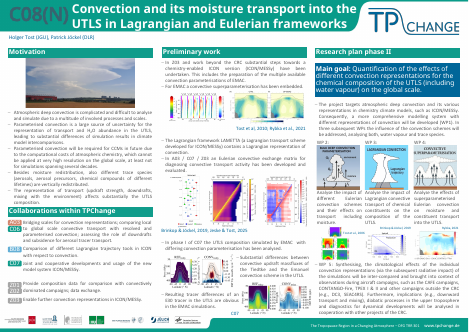
Project C08:
Convection and its moisture transport into the UTLS in Lagrangian and Eulerian frameworks
Brief Summary
Atmospheric convection is often represented by large thunderstorms, so-called cumulonimbus clouds. However, as those clouds are usually to small to be properly represented in climate models, their effects have to be described with the help of parameterisations. However, there are quite some differences how the convection, but especially the effect of vertical redistribution of energy, moisture and trace species can be simulated. Three conceptually different approaches for representing convection in large-scale models will be intercompared in a comprehensive simulation framework based on the ICON model which allows a fair comparison of those representations and their respective advantages and disadvantages in climate modelling. Using a set of classical Eulerian (i.e., grid box related) convection schemes, their individual representations and the strength of transport of compounds into the UTLS will be compared with Lagrangian approaches, which aim at following (artificial) air parcels through the troposphere. Simulation results from both representations will be compared with a so-called superparameterisation, in which a fine-scale model which is able to directly represent cumulonimbus clouds, is applied in each grid cell of a climate model. As the latter approach is computationally expensive, but can serve as a good benchmark for deep penetrating convection into the UTLS in reality, measures for improving the computationally more simplified approaches, allowing for long-term climate predictions.
Project Poster
Members

Prof. Dr. Holger Tost
Principal Investigator
Johannes Gutenberg-Universität Mainz, Institut für Physik der Atmosphäre
tosth[at]uni-mainz.de

Dr. Patrick Jöckel
Principal Investigator
Deutsches Zentrum für Luft- und Raumfahrt, Institut für Physik der Atmosphäre
patrick.joeckel[at]dlr.de
Publications
t.b.d.


